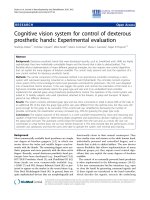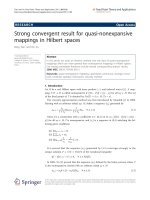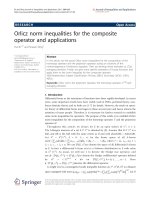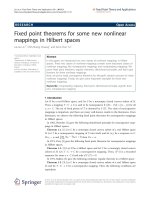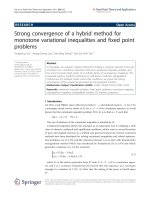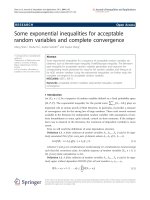Báo cáo hóa học: "STRONG CONVERGENCE THEOREMS FOR ASYMPTOTICALLY NONEXPANSIVE MAPPINGS AND ASYMPTOTICALLY NONEXPANSIVE SEMIGROUPS" ppt
Bạn đang xem bản rút gọn của tài liệu. Xem và tải ngay bản đầy đủ của tài liệu tại đây (518.5 KB, 11 trang )
STRONG CONVERGENCE THEOREMS FOR
ASYMPTOTICALLY NONEXPANSIVE MAPPINGS AND
ASYMPTOTICALLY NONEXPANSIVE SEMIGROUPS
YONGFU SU AND XIAOLONG QIN
Received 22 April 2006; Accepted 14 July 2006
Strong convergence theorems are obtained from modified Halpern iterative scheme for
asymptotically nonexpansive mappings and asymptotically nonexpansive semig roups, re-
spectively. Our results extend and improve the recent ones announced by Nakajo, Taka-
hashi, Kim, Xu, and some others.
Copyright © 2006 Y. Su and X. Qin. This is an open access article distributed under the
Creative Commons Attribution License, which permits unrestricted use, distribution,
and reproduction in any medium, provided the original work is properly cited.
1. Introduction and preliminary
Let H be a real Hilbert space, C a nonempty closed convex subset of H,andT : C
→ C a
mapping. Recall that T is nonexpansive if
Tx− Ty≤x − y∀x, y ∈ C, (1.1)
and T is asymptotically nonexpansive if there exists a sequence
{k
n
} of positive real num-
bers with lim
n→∞
k
n
= 1 and such that
T
n
x − T
n
y
≤
k
n
x − y∀n ≥ 1, x, y ∈ C. (1.2)
Apointx
∈ C is a fixed point of T provided Tx = x. Denote by F(T) the set of fixed points
of T; that is, F(T)
={x ∈ C : Tx = x}. Also, recall that a family S ={T(s) | 0 ≤ s<∞} of
mappings from C into itself is called an asymptotically nonexpansive semigroup on C if
it satisfies the following conditions:
(i) T(0)x
= x for all x ∈ C;
(ii) T(s +t)
= T(s)T(t)foralls,t ≥ 0;
(iii) there exists a positive valued function L :[0,
∞) → [1,∞) such that lim
s→∞
L
s
= 1
and
T(s)x − T(s)y≤L
s
x − y for all x, y ∈ C and s ≥ 0;
(iv) for all x
∈ C, s → T(s)x is continuous.
Hindawi Publishing Corporation
Fixed Point Theory and Applications
Volume 2006, Article ID 96215, Pages 1–11
DOI 10.1155/FPTA/2006/96215
2 Nonexpansive mapping
We denote by F(S) the set of all common fixed points of S, that is, F(S)
=
0≤s<∞
F(T(s)). It is known that F(S) is closed and convex. Construction of fixed point of non-
expansive mapping is an important subject in the theory of nonexpansive mappings and
finds applications in a number of applied areas, in particular, in image recovery and signal
processing (see, e.g., [14, 15]). However, the sequence
{T
n
x}
∞
n=0
of iterates of the map-
ping T at a point x
∈ C may not converge in the weak topology. Thus averaged iterations
prevail. In fact, Mann’s iterations do have weak convergence. More precisely, Mann’s iter-
ation procedure is a sequence
{x
n
} defined by
x
n+1
= α
n
x
n
+
1 − α
n
Tx
n
, (1.3)
where the initial guess x
0
∈ C is chosen arbitrarily.
Reich [9]provedthatifE is a uniformly convex Banach space with a Fr
´
echet differen-
tiable norm and if
{α
n
} is chosen such that
∞
n=1
α
n
(1 − α
n
) =∞, then the sequence {x
n
}
defined by (1.3) converges weakly to a fixed point of T. However we note that Mann’s
iterations have only weak convergence even in a Hilbert space [1].
Recently many authors want to modify the Mann iteration method (1.3)sothatstrong
convergence is guaranteed have recently been made. Nakajo and Takahashi [8]proposed
the following modification of the Mann iteration (1.3) for a single nonexpansive mapping
T in a Hilber t space:
x
0
∈ C arbitrarily,
y
n
= α
n
x
n
+
1 − α
n
Tx
n
,
C
n
=
z ∈ C :
y
n
− z
≤
x
n
− z
,
Q
n
=
z ∈ C :
x
0
− x
n
,x
n
− z
≥
0
,
x
n+1
= P
C
n
∩Q
n
x
0
,
(1.4)
where P
K
denotes the metric projection from H onto a closed convex subset K of H and
proved that sequence
{x
n
} converges strongly to P
F(T)
x
0
.
They also proposed the following iteration process for a nonexpansive semigroup S
=
{
T(s)|0 ≤ s<∞} in a Hilbert space H:
x
0
∈ C arbitrarily,
y
n
= α
n
x
n
+
1 − α
n
1
t
n
t
n
0
T(s)x
n
ds,
C
n
=
z ∈ C :
y
n
− z
≤
x
n
− z
,
Q
n
=
z ∈ C :
x
0
− x
n
,x
n
− z
≥
0
,
x
n+1
= P
C
n
∩Q
n
x
0
.
(1.5)
They proved that if the sequence
{α
n
} is bounded from one and if {t
n
} is a positive
real divergent sequence, then the sequence
{x
n
} generated by (1.5) converges strongly to
P
F(S)
x
0
.
Y. Su and X. Qi n 3
Halpern [3] firstly studied iteration scheme as follows:
x
n+1
= α
n
u +
1 − α
n
Tx
n
, n ≥ 0, (1.6)
where u,x
0
∈ C are arbitrary (but fixed) and {α
n
}⊂(0,1). He pointed out that the con-
ditions lim
n→∞
α
n
= 0and
∞
n=1
α
n
=∞are necessary in the sense that if the iteration
scheme (1.6) converges to a fixed point of T, then these conditions must be satisfied. Ten
years later, Lions [6] investigated the general case in Hilbert space under the conditions
lim
n→∞
α
n
= 0,
∞
n=1
α
n
=∞,lim
n→∞
α
n
− α
n+1
α
2
n+1
= 0 (1.7)
on the parameters. However, Lions’ conditions on the parameters were more restric-
tive and did not include the natural candidate
{α
n
= 1/n}.Reich[10] gave the iteration
scheme (1.6) in the case when E is uniformly smooth and α
n
= n
−δ
with 0 <δ<1.
Wittmann [13] studied the iteration scheme (1.6) in the case when E is a Hilbert space
and
{α
n
} satisfies
lim
n→∞
α
n
= 0,
∞
n=1
α
n
=∞,
∞
n=1
α
n+1
− α
n
< ∞. (1.8)
Reich [11] obtained a strong convergence of the iterates (1.6) with two necessary and
decreasing conditions on parameters for convergence in the case when E is uniformly
smooth with a weakly continuous duality mapping.
Recently, Martinez-Yanes and Xu [7]adaptedtheiteration(1.6) in Hilbert space as
follows:
x
0
∈ C arbitrarily,
y
n
= α
n
x
0
+
1 − α
n
Tx
n
,
C
n
=
z ∈ C :
y
n
− z
2
≤
x
n
− z
2
+ α
n
x
0
2
+2
x
n
− x
0
,z
,
Q
n
=
z ∈ C :
x
0
− x
n
,x
n
− z
≥
0
,
x
n+1
= P
C
n
∩Q
n
x
0
.
(1.9)
More precisely, they prove the following theorem.
Theorem 1.1 (Martinez-Yanes and Xu [7]). Let H be a real Hilbert space, C aclosedconvex
subset of H,andT : C
→ C a nonexpansive mapping such that F(T) =∅. Assume that
{α
n
}⊂(0,1) is such that lim
n→∞
α
n
= 0.Thenthesequence{x
n
} defined by (1.9)converges
strongly to P
F(T)
x
0
.
The purpose of this paper is to employ Nakajo and Takahashi’s [8]ideatomodifypro-
cess (1.6) for asymptotically nonexpansive mappings and asymptotically nonexpansive
semigroup to have strong convergence theorem in Hilbert space.
In the sequel, we need the following lemmas for the proof of our main results.
4 Nonexpansive mapping
Lemma 1.2. Let K beaclosedconvexsubsetofrealHilbertspaceH and le t P
K
be the metric
projection from H onto K (i.e., for x
∈ H, P
k
is the only point in K such that x − P
k
x=
inf{x − z : z ∈ K}). Given x ∈ H and z ∈ K. Then z = P
K
x if and only if there holds the
relations
x − z, y − z≤0 ∀y ∈ K. (1.10)
Lemma 1.3(Linetal.[5]). Let T be an asymptotically nonexpansive mapping defined on a
bounded closed convex subset C of a Hilbert space H. Assume that
{x
n
} is a sequence in C
with the properties (i) x
n
p and (ii) Tx
n
− x
n
→ 0. Then p ∈ F(T).
Lemma 1.4 (Kim and Xu [4]). Let C be a nonexpansive bounded closed convex subset of H
and let S
={T(t):0≤ t<∞} be an asymptotically nonexpansive semigroup on C.Thenit
holds that
limsup
s→∞
limsup
n→∞
sup
x∈C
T(s)
1
t
t
0
T(u)x
n
du
−
1
t
t
0
T(u)x
n
du
=
0. (1.11)
Lemma 1.5. Let C be a nonex pansive bounded closed convex subset of H and let S
={T(s):
0
≤ s<∞} be an asymptotically nonexpansive semigroup o n C.If{x
n
} isasequencein
C satisfying the properties (i) x
n
z; (ii) limsup
s→∞
limsup
n→∞
T(s)x
n
− x
n
=0, then
z
∈ F(S).
Proof. This lemma is the continuous version of [12, Lemma 2.3]. The proof given in [12]
is easily extended to the continuous case.
2. Main results
In this section we propose a modification of the Halpern iteration method to have strong
convergence for asymptotically nonexpansive mappings and asymptotically nonexpan-
sive semigroup in Hilbert space.
Theorem 2.1. Let C be a bounded closed convex subset of a Hilbert space H and let T : C
→
C be an asymptotically nonexpansive mapping with sequence {k
n
}. Assume that {α
n
}
∞
n=0
and {β
n
}
∞
n=0
are sequences in (0,1) such that lim
n→∞
α
n
= 0, lim
n→∞
β
n
= 1,andM is an
appropriate constant such that M
≥x
0
− v
2
,forallv ∈ C.Defineasequence{x
n
} in C by
the following algorithm:
x
0
∈ C chosen arbitrarily,
z
n
= β
n
x
n
+
1 − β
n
T
n
x
n
,
y
n
= α
n
x
0
+
1 − α
n
T
n
z
n
,
C
n
=
v ∈ C :
y
n
− v
2
≤
x
n
− v
2
+
z
n
2
−
x
n
2
+2
x
n
− z
n
,v
+ α
n
M
,
Q
n
=
v ∈ C :
x
0
− x
n
,x
n
− v
≥
0
,
x
n+1
= P
C
n
∩Q
n
x
0
.
(2.1)
Then
{x
n
} converges to P
F(T)
x
0
,providedk
2
n
(1 − α
n
) − 1 ≤ 0.
Y. Su and X. Qi n 5
Proof. From [2]weknowthatT has a fixed point in C. That is, F(T)
=∅.Itisobviously
that C
n
is closed and Q
n
is closed and convex for each n ≥ 0. Next observe that C is
convex. For v
1
,v
2
∈ C
n
and t ∈ (0,1), putting v = tv
1
+(1− t)v
2
.Itissufficient to show
that v
∈ C
n
. Indeed, the defining inequality in C
n
is equivalent to the inequality
2
z
n
− y
n
, v
≤
z
n
2
−
y
n
2
+ α
n
M. (2.2)
Therefore, we have
2
z
n
− y
n
,v
=
2
z
n
− y
n
,tv
1
+(1− t)v
2
=
2t
z
n
− y
n
,v
1
+2(1− t)
z
n
− y
n
,v
2
≤
z
n
2
−
y
n
2
+ α
n
M,
(2.3)
which implies that C is convex. Next, we show that F(T)
⊂ C
n
for all n. Indeed, for each
p
∈ F(T),
y
n
− p
2
=
α
n
x
0
− p +
1 − α
n
T
n
z
n
− p
2
≤ α
n
x
0
− p
2
+
1 − α
n
k
2
n
z
n
− p
2
≤
x
n
− p
2
−
x
n
− p
2
+ α
n
x
0
− p
2
+
1 − α
n
k
2
n
z
n
− p
2
≤
x
n
− p
2
+
z
n
− p
2
−
x
n
− p
2
+ α
n
x
0
− p
2
≤
x
n
− p
2
+
z
n
2
−
x
n
2
+2
x
n
− z
n
, p
+ α
n
M.
(2.4)
Therefore, p
∈ C
n
for each n ≥ 1, which implies that F(T) ⊂ C
n
. Next we show that
F(T)
⊂ Q
n
∀n ≥ 0. (2.5)
We prove this by induction. For n
= 0, we have F(T) ⊂ C = Q
0
. Assume that F(T) ⊂ Q
n
.
Since x
n+1
is the projection of x
0
onto C
n
∩ Q
n
,byLemma 1.2 we have
x
0
− x
n+1
,x
n+1
− z
≥
0 ∀z ∈ C
n
∩ Q
n
. (2.6)
As F(T)
⊂ C
n
∩ Q
n
by the induction assumptions, the last inequality holds, in particu-
lar, for all z
∈ F(T). This to gether with the definition of Q
n+1
implies that F(T) ⊂ Q
n+1
.
Hence (2.5)holdsforalln
≥ 0. In order to prove lim
n→∞
x
n+1
− x
n
=0, from the def-
inition of Q
n
we have x
n
= P
Q
n
x
0
which together with the fact that x
n+1
∈ C
n
∩ Q
n
⊂ Q
n
implies that
x
0
− x
n
≤
x
0
− x
n+1
. (2.7)
This shows that the sequence
{x
n
− x
0
} is nondecreasing. Since C is bounded. We ob-
tain that lim
n→∞
x
n
− x
0
exists. Notice again that x
n
= P
Q
n
x
0
and x
n+1
∈ Q
n
which give
6 Nonexpansive mapping
x
n+1
− x
n
,x
n
− x
0
≥0. Therefore, we have
x
n+1
− x
n
2
=
x
n+1
− x
0
−
x
n
− x
0
2
≤
x
n+1
− x
0
2
−
x
n
− x
0
2
− 2
x
n+1
− x
n
,x
n
− x
0
≤
x
n+1
− x
0
2
−
x
n
− x
0
2
.
(2.8)
It follows that
lim
n→∞
x
n
− x
n+1
=
0. (2.9)
On the other hand, It follows from x
n+1
∈ C
n
that
y
n
− x
n+1
2
≤
x
n
− x
n+1
2
+
z
n
2
−
x
n
2
+2
x
n
− z
n
,x
n+1
+ α
n
M. (2.10)
It follows from (2.1)andlim
n→∞
β
n
= 1that
z
n
− x
n
=
1 − β
n
x
n
− T
n
x
n
−→
0. (2.11)
Next, we consider
z
n
2
−
x
n
2
+2
x
n
− z
n
,x
n+1
=
z
n
2
+
x
n
2
− 2
z
n
,x
n
+2
x
n
− z
n
,x
n+1
−
2
x
n
2
+2
z
n
,x
n
=
z
n
− x
n
2
+2
x
n
− z
n
,x
n+1
−
2
x
n
2
+2
z
n
,x
n
=
z
n
− x
n
2
+2
z
n
,x
n
− x
n+1
−
2
x
n
2
+2
x
n
,x
n+1
.
(2.12)
Therefore, it follows from (2.9)and(2.11)that
z
n
2
−
x
n
2
+2
x
n
− z
n
,x
n+1
−→
0. (2.13)
Furthermore, from (2.9), (2.13), and lim
n→∞
α
n
= 0, we obtain
lim
n→∞
y
n
− x
n+1
=
0. (2.14)
On the other hand, we consider
y
n
− T
n
x
n
≤
y
n
− T
n
z
n
+
T
n
z
n
− T
n
x
n
≤
α
n
x
0
− T
n
z
n
+ k
n
z
n
− x
n
=
α
n
x
0
− T
n
z
n
+ k
n
1 − β
n
x
n
− T
n
x
n
.
(2.15)
Y. Su and X. Qi n 7
Therefore, it follows that
x
n
− T
n
x
n
≤
x
n
− x
n+1
+
x
n+1
− y
n
+
y
n
− T
n
x
n
≤
x
n
− x
n+1
+
x
n+1
− y
n
+ α
n
x
0
− T
n
z
n
+ k
n
1 − β
n
x
n
− T
n
x
n
.
(2.16)
That is,
1 − k
n
1 − β
n
x
n
− T
n
x
n
≤
x
n
− x
n+1
+
x
n+1
− y
n
+ α
n
x
0
− T
n
z
n
. (2.17)
It follows from lim
n→∞
β
n
= 1, lim
n→∞
α
n
= 0, (2.9), and (2.14)that
lim
n→∞
x
n
− T
n
x
n
−→
0. (2.18)
Putting
k = sup{k
n
: n ≥ 1} < ∞,weobtain
Tx
n
− x
n
≤
Tx
n
− T
n+1
x
n
+
T
n+1
x
n
− T
n+1
x
n+1
+
T
n+1
x
n+1
− x
n+1
+
x
n+1
− x
n
≤
k
x
n
− T
n
x
n
+
1+k
x
n
− x
n+1
+
T
n+1
x
n+1
− x
n+1
,
(2.19)
which implies that
Tx
n
− x
n
−→
0. (2.20)
Assume that
{x
n
i
} is a subsequence of {x
n
} such that x
n
i
x.ByLemma 1.3 we hav e
x ∈ F(T). Next we show that x = P
F(T)
x
0
and the convergence is strong. Put x = P
F(T)
x
0
and consider the sequence {x
0
− x
n
i
}.Thenwehavex
0
− x
n
i
x
0
− x and by the weak
lower semicontinuity of the norm and by the fact that
x
0
− x
n+1
≤x
0
− x for all n ≥ 0
which is implied by the fact that x
n+1
= P
C
n
∩Q
n
x
0
,wehave
x
0
− x
≤
x
0
− x
≤
liminf
i→∞
x
0
− x
n
i
≤
limsup
i→∞
x
0
− x
n
i
≤
x
0
− x
. (2.21)
This gives
x
0
− x
=
x
0
− x
,
x
0
− x
n
i
−→
x
0
− x
. (2.22)
It follows that x
0
− x
n
i
→ x
0
− x;hence,x
n
i
→ x.Since{x
n
i
} is an arbitrary subsequence of
{x
n
},weconcludethatx
n
→ x. The proof is completed.
8 Nonexpansive mapping
Theorem 2.2. Let C be a nonempty bounded closed convex subset of H and let S
={T(s):
0
≤ s<∞} be an asymptotically nonexpansive semigroup on C. Assume that {α
n
}
∞
n=0
and
{β
n
}
∞
n=0
are seque nces in (0,1) such that lim
n→∞
α
n
= 0 and lim
n→∞
β
n
= 1. {t
n
} is a positive
real divergent sequence and M is an appropriate constant such that M
≥x
0
− v for all
v
∈ C. Define a sequence {x
n
} in C by the following algori thm:
x
0
∈ C chosen arbitrarily,
z
n
= β
n
x
n
+
1 − β
n
1
t
n
t
n
0
T(s)x
n
ds,
y
n
= α
n
x
0
+
1 − α
n
1
t
n
t
n
0
T(s)z
n
ds,
C
n
=
v ∈ C :
y
n
− v
2
≤ α
n
x
n
− v
2
+
z
n
2
−
x
n
2
+2
x
n
− z
n
,v
+ α
n
M
,
Q
n
=
v ∈ C :
x
0
− x
n
,x
n
− z
≥
0
,
x
n+1
= P
C
n
∩Q
n
x
0
.
(2.23)
Then
{x
n
} converges to P
F(S)
x
0
,provided((1/t
n
)
t
n
0
L
s
dt)
2
(1 − α
n
) − 1 ≤ 0.
Proof. We only conclude the difference. First we show F(S)
⊂ C
n
.ItfollowsfromC is
bounded, we obtain that F( S)
=∅(see [12]). Taking p ∈ F(S), we have
y
n
− p
2
≤ α
n
x
0
− p
2
+
1 − α
n
1
t
n
t
n
0
T(s)z
n
ds− p
2
≤ α
n
x
0
− p
2
+
1 − α
n
1
t
n
t
n
0
T(s)z
n
− p
ds
2
≤ α
n
x
0
− p
2
+
1 − α
n
1
t
n
t
n
0
L
s
ds
2
z
n
− p
2
=
x
n
− p
2
+
z
n
− p
2
−
x
n
− p
2
+ α
n
x
0
− p
2
≤
x
n
− p
2
+
z
n
2
−
x
n
2
+2
x
n
− z
n
, p
+ α
n
M.
(2.24)
It follows that F(S)
⊂ C
n
for each n ≥ 0. From the proof of Theorem 2.1 we have the se-
quence
{x
n
} is well defined and F(S) ⊂ C
n
∩ Q
n
for each n ≥ 0. Similarly to the argument
of Theorem 2.1 and noticing q
= P
F(S)
x
0
,wehavex
n+1
− x
0
≤q − x
0
for each n ≥ 0
and
x
n+1
− x
n
→0. Next, we assume that a subsequence {x
n
i
} of {x
n
} converges weakly
Y. Su and X. Qi n 9
to q. It follows that
T(s)x
n
− x
n
≤
T(s)x
n
− T(s)
1
t
n
t
n
0
T(s)x
n
ds
+
T(s)
1
t
n
t
n
0
T(s)x
n
ds
−
1
t
n
t
n
0
T(s)x
n
ds
+
1
t
n
t
n
0
T(s)x
n
ds− x
n
≤
2
1
t
n
t
n
0
T(s)x
n
ds− x
n
+
T(s)
1
t
n
t
n
0
T(s)x
n
ds
−
1
t
n
t
n
0
T(s)x
n
ds
,
(2.25)
for each n
≥ 0. It follows from (2.23)that
y
n
−
1
t
n
t
n
0
T(s)z
n
ds
≤
α
n
x
0
−
1
t
n
t
n
0
T(s)z
n
ds
. (2.26)
Therefore, we obtain
y
n
−
1
t
n
t
n
0
T(s)z
n
ds
−→
0. (2.27)
Next, we consider the first term on the right-hand side of (2.25)
1
t
n
t
n
0
T(s)x
n
ds− x
n
≤
x
n
− x
n+1
+
x
n+1
− y
n
+
y
n
−
1
t
n
t
n
0
T(s)x
n
ds
. (2.28)
Since x
n+1
∈ C
n
,wehave
y
n
− x
n+1
2
≤ α
n
x
n
− x
n+1
2
+
z
n
2
−
x
n
2
+2
x
n
− z
n
,x
n+1
+ α
n
M. (2.29)
Similar to the proof of Theorem 2.1,wehave
lim
n→∞
y
n
− x
n+1
=
0, (2.30)
and hence
y
n
−
1
t
n
t
n
0
T(s)x
n
ds
≤
y
n
−
1
t
n
t
n
0
T(s)z
n
ds
+
1
t
n
t
n
0
T(s)z
n
ds−
1
t
n
t
n
0
T(s)x
n
ds
≤
y
n
−
1
t
n
t
n
0
T(s)z
n
ds
+
1
t
n
t
n
0
T(s)z
n
− T(s)x
n
ds
≤
y
n
−
1
t
n
t
n
0
T(s)z
n
ds
+
1
t
n
t
n
0
L
s
ds
z
n
− x
n
2
.
(2.31)
10 Nonexpansive mapping
Since lim
n→∞
β
n
= 1, we have
z
n
− x
n
=
1 − β
n
x
n
−
1
t
n
t
n
0
T(s)x
n
ds
−→
0. (2.32)
It follows from (2.27)and(2.32)that
y
n
−
1
t
n
t
n
0
T(s)x
n
ds
−→
0. (2.33)
It follows from (2.30)and(2.33)that
x
n
−
1
t
n
t
n
0
T(s)x
n
ds
−→
0. (2.34)
On the other hand, by using Lemma 1.4 we obtain
limsup
s→∞
limsup
n→∞
T(s)
1
t
n
t
n
0
T(s)x
n
ds
−
1
t
n
t
n
0
T(s)x
n
ds
=
0. (2.35)
It follows from (2.34)and(2.35)that
limsup
s→∞
limsup
n→∞
T(s)x
n
− x
n
=
0. (2.36)
Assume that a
{x
n
i
} is a subsequence of {x
n
} such that {x
n
i
} q ∈ C,thenq ∈ F(S)
(by Lemma 1.5). Next we show that q
= Π
F(S)
x
0
and the convergence is strong. Put q
=
Π
F(S)
x
0
,fromx
n+1
= Π
C
n
∩Q
n
x
0
and q
∈ F(S) ⊂ C
n
∩ Q
n
,wehavex
n+1
− x
0
≤q
− x
0
.
On the other hand, from weakly lower semicontinuity of the norm, we obtain
q
− x
0
≤
x
0
− q
≤
liminf
i→∞
x
0
− x
n
i
≤
limsup
i→∞
x
0
− x
n
i
≤
q − x
0
.
(2.37)
It follows from definition of Π
F(S)
x
0
that we obtain q = Π
F(S)
x
0
and hence
q
− x
0
=
q − x
0
. (2.38)
It follows that x
n
i
→ q
.Since{x
n
i
} is an arbitrarily weakly convergent sequence of {x
n
},
we can conclude that
{x
n
} convergesstronglytoonepointofΠ
F(S)
x
0
. This completes the
proof.
References
[1] A. Genel and J. Lindenstrauss, An example concerning fixed points, Israel Journal of Mathematics
22 (1975), no. 1, 81–86.
[2] K. Goebel and W. A. Kirk, A fixed point theorem for asymptotically nonexpansive mappings,Pro-
ceedings of the American Mathematical Society 35 (1972), no. 1, 171–174.
Y. Su and X. Qin 11
[3] B. Halpern, Fixed points of nonexpanding maps, Bulletin of the American Mathematical Society
73 (1967), 957–961.
[4] T H. Kim and H K. Xu, Strong convergence of modified Mann iterations for asymptotically non-
expansive mappings and semigroups, Nonlinear Analysis 64 (2006), no. 5, 1140–1152.
[5] P K. Lin, K K. Tan, and H K. Xu, Demiclosedness principle and asymptotic behavior for asymp-
totically nonexpansive mappings, Nonlinear Analysis 24 (1995), no. 6, 929–946.
[6] P L. Lions, Approximation de points fixes de contractions, Comptes Rendus de l’Acad
´
emie des
Sciences de Paris, S
´
erie. A-B 284 (1977), no. 21, A1357–A1359.
[7] C. Martinez-Yanes and H K. Xu, Strong convergence of the CQ method for fixed point iteration
processes, Nonlinear Analysis 64 (2006), no. 11, 2400–2411.
[8] K. Nakajo and W. Takahashi, Strong convergence theorems for nonexpansive mappings and nonex-
pansive semigroups, Journal of Mathematical Analysis and Applications 279 (2003), no. 2, 372–
379.
[9] S. Reich, Weak convergence theorems for nonexpansive mappings in Banach spaces,Journalof
Mathematical Analysis and Applications 67 (1979), no. 2, 274–276.
[10]
, Strong conve rgence theorems for resolvents of accretive operators in Banach spaces,Journal
of Mathematical Analysis and Applications 75 (1980), no. 1, 287–292.
[11]
, Approximating fixed points of nonexpansive mappings, Panamerican Mathematical Jour-
nal 4 (1994), no. 2, 23–28.
[12] K K. Tan and H K. Xu, Fixed point theorems for Lipschitzian semigroups in Banach spaces,Non-
linear Analysis 20 (1993), no. 4, 395–404.
[13] R. Wittmann, Approximationoffixedpointsofnonexpansivemappings, Archiv der Mathematik
58 (1992), no. 5, 486–491.
[14] D. Youla, Mathematical theory of image restoration by the method of convex projections,Image
Recovery Theory and Application (H. Stark, ed.), Academic Press, Florida, 1987, pp. 29–77.
[15]
, On deterministic convergence of iteration of relaxed projection operators, Journal of Visual
Communication and Image Representation 1 (1990), no. 1, 12–20.
Yongfu Su: Department of Mathematics, Tianjin Polytechnic University, Tianjin 300160, China
E-mail address:
Xiaolong Qin: Department of Mathematics, Tianjin Polytechnic University, Tianjin 300160, China
E-mail address:


